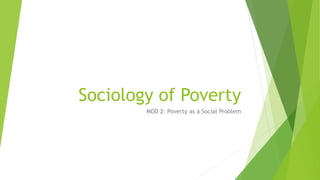
Module 2: Poverty as a Social Problem
- 1. Sociology of Poverty MOD 2: Poverty as a Social Problem
- 2. Visibility of Poverty Poverty isn’t considered enough of an “urgent social problem” (p. 1) The issue of poverty was more visible in the early 1960s and through the Civil Rights Era Lyndon Johnson declared an “unconditional war on poverty” in 1964 Martin Luther King Jr. called the country to live up to its “democratic ideals and moral principles” Notable attention to poverty came from: Hurricane Katrina (2005) Great Recession of 2007-2009 Election of Obama (2008) Rise of Tea Party (2009) Occupy Wall Street movement (2011)
- 3. Is the Problem Poverty or the Poor? Royce (2015) argues against the individualistic explanations for poverty (resulting from bad decision-making, moral weaknesses, bad behavior, etc.) A structuralist perspective is what we need to better understand poverty and hope to make a positive difference
- 4. Official Rate of Poverty In 2012, there were 46.5 million Americans living in poverty (15% of the population) 61 million have incomes below 125% of the poverty line 106 million have income below twice the poverty line ($48,000 a year for family of four) “The real poverty population is substantially larger than the official poverty population” (as cited in Royce, 2015, p. 7) In 2009, the US ranked #1 in child poverty compared to 26 developed nations
- 5. Poverty in the U.S. Poverty has remained high over the past 40 years The poverty rate declined during the 1960s Remained stable during the 1970s Increased during the 1980s and stayed high throughout the 1990s Reached a record low (11.3%) in 2000 Increased again during/after recession of 2007-2009 and reached 15% in 2012
- 6. Levels of Poverty Relative poverty Although the poverty rate and experience is higher in the U.S. compared to other industrialized nation, it’s nothing compared to global poverty in the Third World Deep poverty Includes those with income below 50% of the poverty threshold Extreme poverty (households reported $2 or less per day per person) Increased after welfare reform in 1996 that instituted lifetime cash benefit limits
- 7. The Lived Experience “The standard of living for average Americans has improved modestly over the past several decades, while at the same time the poor have become more deeply poor” (p. 10) Poor Americans are more vulnerable to “social exclusion” and less likely to experience intergenerational social mobility Poor children are highly likely to inherit their parents’ economic status It’s difficult to escape the culture of poverty Most extreme example of these trends are seen within African American households “Over 90 percent endure at least one year of adult poverty” (p. 13)
- 8. Wealth vs. Income The distribution of wealth is far more unequal than the distribution of income In 2010, the richest 1% of American households received 17.2% of the nation’s income, but 35.4% of the total wealth In 2010, the bottom 90% of American households received 55.5% of the nation’s income, and 23.3% of the total wealth Wealth inequality contributes to “asset poverty,” which is when a family has no personal safety (not have enough funds to cover basic costs for at least 3 months) Includes almost half of all American households!
- 9. The Middle-Class Middle-income Americans are worst off than they used to be and they’re facing more and more difficulties in getting by Fred Block’s “four H’s” – costs for housing, high-quality child care, higher education, and health insurance – have dramatically increased since the 1970s
- 10. Poverty as a Social Justice Issue U.S. ranks near the bottom compared to other industrialized nations on the Social Justice Index (developed by the Bertelsmann Foundation), which measures opportunities provided for self-determination (6 dimensions): Poverty prevention Access to education Labor market inclusion Social cohesion and non-discrimination Health Intergenerational justice Additional examples that poverty in the U.S. is a social justice issue: Food insecurity (21 million kids on subsidized school lunches, up from 18 million before 2017) Income inequality (Income of CEOs of S&P 500 companies in 2012 was 354 times hourly employees’)
- 11. Individualistic vs. Structural Perspectives These two frameworks represent an ideological divide in the U.S. Individualistic Perspective: America is a meritocracy where hard work and determination pays off “Poverty results from individual weaknesses, failings, and inadequacies” (p. 20) Structural Perspective: Income and wealth in America is based on power distributed in an economic and political system Poverty is due to various “economic, political, cultural, and social forces outside the immediate control of the individual” (p. 20)
- 12. Poverty as a Structural Problem The structural perspective focuses on: Four systems (economic, political, cultural, social) Ten obstacles (racial discrimination, residential segregation, housing, education, transportation, sex discrimination, child care, health care, retirement insecurity, and legal deprivation) “Poverty is a structural problem insofar as the hardships of the poor and the persistence of their poverty can be traced back to these obstacles rather than to the failings and deficiencies of poor people themselves” (p. 23)